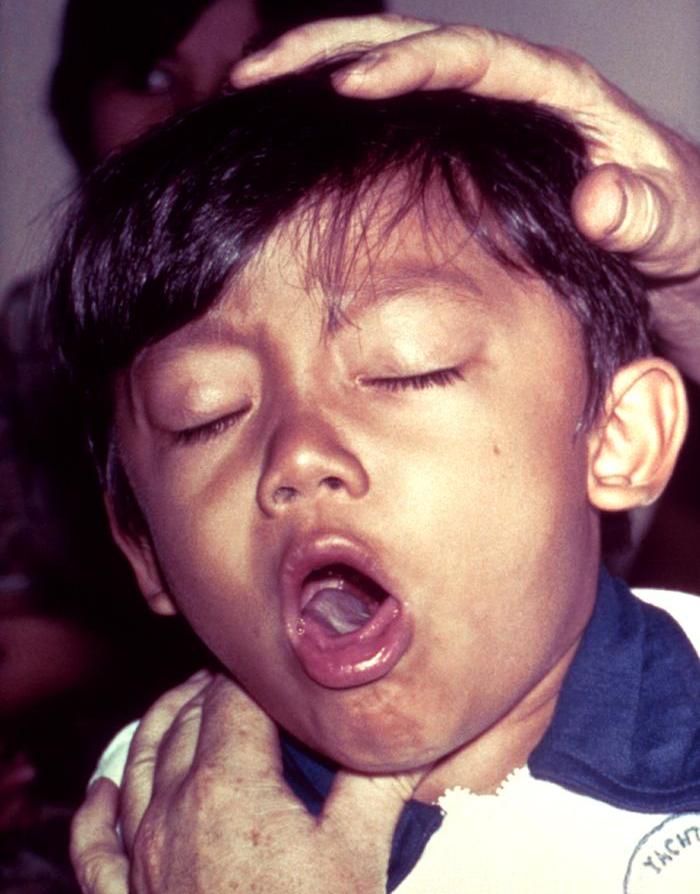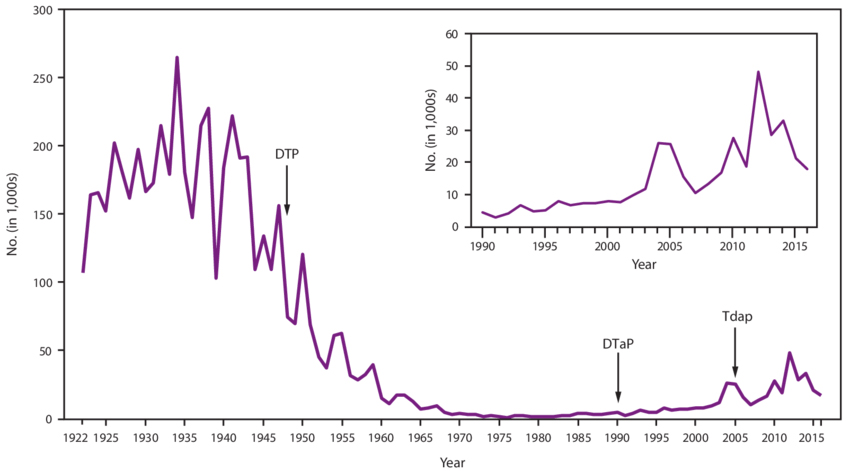What is Pertussis?

IMPORTANT NOTE: Corvelva invites you to get in-depth information by reading all the sections and links, as well as the manufacturer's product leaflets and technical data sheets, and to speak with one or more trusted professionals before deciding to vaccinate yourself or your child. This information is for informational purposes only and is not intended as medical advice.
 Whooping cough, commonly called "whooping cough", is a highly contagious respiratory disease caused by the bacterium Bordetella (B.) pertussis. The B. pertussis bacteria attach themselves to the mucous membranes of the respiratory tract and cause inflammation in the body.(1) The main symptom of B. pertussis whooping cough disease is an uncontrollable cough.(2)
Whooping cough, commonly called "whooping cough", is a highly contagious respiratory disease caused by the bacterium Bordetella (B.) pertussis. The B. pertussis bacteria attach themselves to the mucous membranes of the respiratory tract and cause inflammation in the body.(1) The main symptom of B. pertussis whooping cough disease is an uncontrollable cough.(2)
In advanced stages, thick mucus builds up in the lungs and blocks the air passages, triggering violent episodes of coughing and mucus vomiting followed by sharp breathing. With whooping cough disease, you may experience coughing so violently, especially at night, that you vomit large amounts of mucus through your mouth and nose and interfere with breathing.(2)
The B. pertussis bacterium releases several toxins, including pertussis toxin (PT) and endotoxin. In severe cases of whooping cough, complications include high fever, brain inflammation, seizures, pneumonia, pneumothorax, hernias, subdural hematomas, and death.(4)
The initial symptoms of B. pertussis are similar to those of a common cold or an allergy attack, with a stuffy or runny nose, dry cough, loss of appetite, fatigue, and sometimes a low-grade fever. After a week or two, the disease usually progresses to spasmodic coughing fits (paroxysms) with large amounts of mucus, retching, and vomiting with or without whistling, worse at night.(5) During the day, the child or adult may look and feel well, with the exception of frequent coughing spasms. A final phase of recovery with only occasional coughing fits can last for weeks or even months.(6)
Sometimes infants or toddlers and older adults don't cough with a cough. Newborns and very young children who gasp may have a flushed face, bulging eyes, blue lips, and may stop breathing for a few seconds or longer because thick mucus blocks their small airways.(7) Sometimes babies need to have mucus suctioned from the throat in order to breathe.(8)
Adults and adolescents with whooping cough may have milder symptoms, such as a persistent cough that produces mucus and lasts for 4 to 8 weeks. Older children and adults often do not produce whooping cough when they cough.(9)
Pertussis symptoms are sometimes milder in those who have received one or more doses of pertussis-containing vaccines (DPT, DTaP, Tdap)(10) and doctors or nurses may not suspect B. pertussis pertussis in vaccinated children, adolescents, and adults who present with a bad cough.(11) Many cases of whooping cough go unnoticed because they are misdiagnosed by medical personnel as an allergy attack, bronchitis, flu, or other upper respiratory infection.
The only sure way to find out if you or your child has B. pertussis or Bordetella parapertussis is to have a laboratory test that confirms the exact organism causing the pertussis symptoms.(12) Bordetella parapertussis, another whooping cough disease, may look identical to whooping cough, but the symptoms are usually milder.(13) B. parapertussis is on the rise in the United States and other countries, which have had high pertussis vaccination rates for some decades. By some estimates, perhaps 30% or more of pertussis disease in highly vaccinated populations is caused by B. parapertussis organisms.(14) It is possible to have B. pertussis and B. parapertussis infections at the same time. Parapertussis is often milder than B. pertussis, but it can also lead to serious complications, leading to pneumonia and death.(15) Whooping cough vaccines widely used in the world they do not protect against B. parapertussis. There is no vaccine for B. parapertussis.(16)
What is the epidemiological history of Pertussis?
References (click to open)
- CDC. Pertussis - Bordetella pertussis Epidemiology and Prevention of Vaccine-Preventable Diseases (The Pink Book). 13th ed. 2015.
- Medline Plus. Whooping cough. July 30, 2018
- CDC Pertussis - Signs and Symptoms. Aug. 7, 2017
- CDC. Pertussis - Complications Epidemiology and Prevention of Vaccine-Preventable Diseases (The Pink Book). 13th ed. 2015.
- CDC Pertussis - Signs and Symptoms. Aug. 7, 2017
- Ibid
- Mayo Clinic Whooping cough. Feb. 10, 2018
- CDC Diagnosis and Treatment. Aug. 7, 2017
- Kids Health Infections - Whooping Cough (Pertussis). Feb 2016
- CDC Pertussis Complications. Aug. 7, 2017
- Glick J Doctors Say Whooping Cough Often Misdiagnosed. CBS D.C. Oct. 1, 2015
- CDC Pertussis Diagnosis Confirmation. Aug. 7, 2017
- Bocka JJ. pertussis Medscape. Oct. 20, 2017
- HeQ, Viljanen MK, et al Whooping cough caused by Bordetella pertussis and Bordetella parapertussis in an immunized population. JAMA.1998 Aug 19;280(7):635-7.
- CDC Surveillance Manual Chapter 10: Pertussis - Disease Description. 6th Edition. 2013
- Liese JG, Renner C, Stojanov S, et al Clinical and epidemiological picture of B pertussis and B parapertussis infections after introduction of acellular pertussis vaccines Arch Dis Child 2003; 88: 684-687.
This article is summarized and translated by National Vaccine Information Center.


